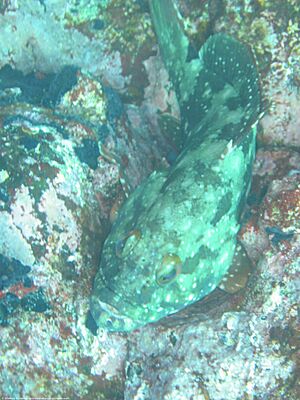Starry grouper facts for kids
Quick facts for kids Starry grouper |
|
|---|---|
 |
|
| A starry grouper swimming near the Galápagos Islands | |
| Conservation status | |
| Scientific classification | |
| Synonyms | |
|
The starry grouper (Epinephelus labriformis), also called the flag cabrilla, is a type of ray-finned fish found in the ocean. It's a grouper, which means it's part of the Serranidae family. This family also includes other fish like sea basses. You can find this fish swimming in the eastern Pacific Ocean.
Contents
What Does It Look Like?
The starry grouper has a strong body that is a bit flat on the sides. Its head and body are usually olive green. They have many white spots and blotches that are not in any special pattern.
You might also see red-brown blotches on its head and the front part of its body. There's a black mark on its back, near its tail. The edges of its top and bottom fins, and the tips of its tail and side fins, are often red.
This fish has two main fins on its back. The first one has 11 stiff spines, and the second one has 16 to 18 soft rays. Its tail fin is rounded. The starry grouper can grow up to 60 centimeters (about 2 feet) long.
Where Does It Live?
The starry grouper lives in the warm, tropical waters of the eastern Pacific Ocean. You can find it from Mexico all the way down to Peru. It also lives around several islands far from the coast. These include the Galápagos Islands, Cocos Island, Malpelo Island, and the Revillagigedo Islands.
Habitat and Life
Adult starry groupers are most common in shallow waters. However, they can also be found deeper, up to 30 meters (about 100 feet) down. They like to live in places with rocks and coral reefs near the coast.
The starry grouper is a predator, meaning it hunts other animals for food. It usually lives alone. During the day, it seems to eat smaller fish. After the sun goes down, it hunts for crustaceans, like crabs or shrimp. These fish usually lay their eggs in the late summer.
Who Discovered It?
The starry grouper was first officially described in 1840. An English clergyman and naturalist named Leonard Jenyns gave it the scientific name Serranus labriformis. He found the first one near San Cristóbal Island in the Galápagos Islands.
How People Use It
People often catch the starry grouper for food. It's a popular fish for small-scale fishing in places like the Gulf of California and along the Pacific coast of Mexico. Fishermen catch them all year using hand lines, spearguns, and gill nets.
This fish has become more important to these fishermen. That's because bigger types of groupers have become harder to find due to too much fishing. The starry grouper is also caught in the Galápagos Islands.


